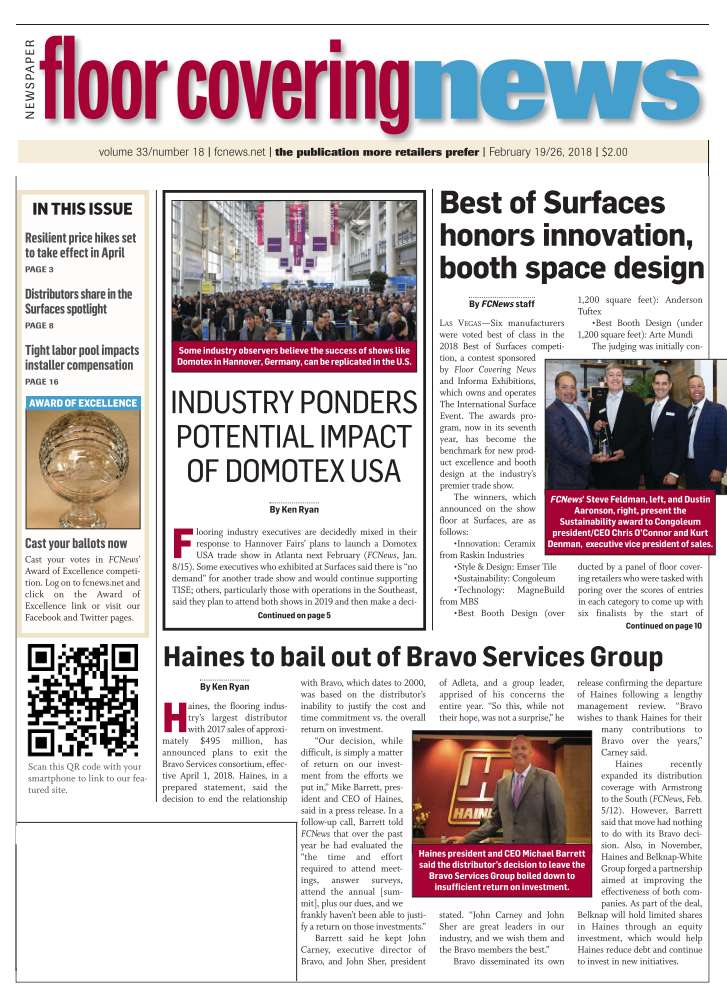February 19/26, 2018: Volume 33, Issue 18
By K.J. Quinn and Nicole Murray
Several of the industry’s major players have invested significant capital and resources into the development of next-generation tile flooring and wall products. Judging by the introductions making their respective debuts at various markets this winter, those investments are paying off.
On one hand, advances in digital printing are enabling producers to introduce head-turning formats and designs. At the same time, technological breakthroughs are helping suppliers improve performance and durability. “We are constantly evaluating our technologies, always looking for new ways to improve our product offerings,” said Gianni Mattioli, executive vice president, product and marketing, Dal-Tile. “Our digital printing techniques allow us to create tile that is so realistic, most customers cannot discern between what is tile and what is the natural surface we are imitating.”
Emerging formats such as large slabs are providing a broader canvas for many of these new designs. At Surfaces, Dal-Tile showcased its Panoramic porcelain series available in a 10 x 6 format. Then there’s the Industrial Panoramic series, which comes in four colors, and the Elemental Panoramic series, which comes in seven colors. Tiles for the new collections are available in varied thicknesses including 12mm for countertop applications and 6mm, which is more suitable for the floor or wall applications.
“We had to go bigger because people’s kitchen islands are growing larger and their surrounding counters have larger wrap-arounds,” said Roy Viana, Dal-Tile’s director of slab and natural stone. “Within this collection alone are color and texture options for just about any look to be achievable along with the durable and long-lasting benefits of porcelain.”
Another hot trend in porcelain tile is thinner looks. One of the most significant advantages of thin tile is the ability to be offered in much larger slabs than traditional tile, according to Barbara Haaksma, vice president of marketing, Emser Tile. “Grout lines are the bane of everyone’s existence in the industry. The monolithic look that comes with larger tiles allows for [rooms] to look spacious and, therefore, much more appealing.”
Vance Hunsucker, national sales manager, tile and stone, Shaw Floors, also cited the new tile’s ease of installation. “Gauged porcelain slabs take less time to install since they are manufactured in large pieces and don’t require the same intensity in terms of grouting and cutting that’s inherent with traditional tile formats.”
New designs in products such as porcelain slabs are offering even more incentives for homeowners and specifiers to choose tile for more than just showers and backsplashes. “We see convergence of designs appealing across both commercial and residential,” said David Koenig, vice president and general manager, Crossville Studios, the tile maker’s distribution division. “Porcelain slabs are starting to come into the market and will continue to gain market presence over the next two to three years.”
Aesthetic enhancements
High-definition printing is completely transforming the category, allowing manufacturers to supply consumers with high-quality floor tiles that resemble natural materials. Image resolution, observers say, is integral to creating products with superior characteristics in terms of detail, color fidelity and graphic designs.
The digital printing process has become so sophisticated that manufacturers are creating tiles that vary from piece to piece, much like the real products.
A case in point is Marazzi’s Urban District BRX collection, which closely resembles brick but is actually ceramic tile. Exuding the look of handcrafted bricks, the Urban District BRX line is inspired by 19th century Chicago brick, so realistic consumers will be hard pressed to tell the difference.
One natural look that remains strong in commercial and residential flooring is wood, thanks to the introduction of new graphics and sizes. Longer, wider formats in wood visuals are becoming increasingly popular, Shaw’s Hunsucker said, a trend that is in line with hardwood flooring. “There appears to be a transition away from 6 x 24 formats, which are quickly becoming more of a commodity product within the market.”

